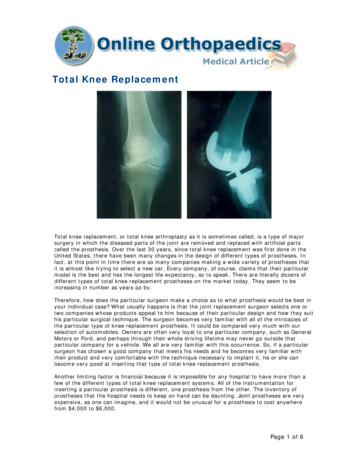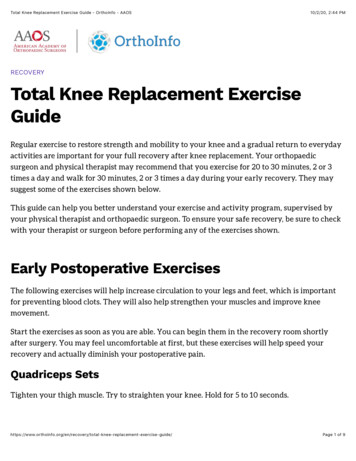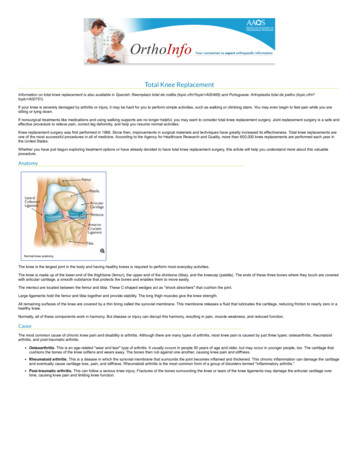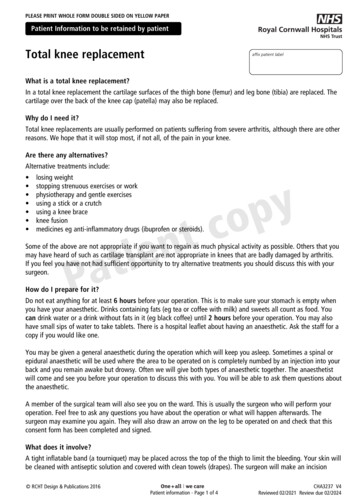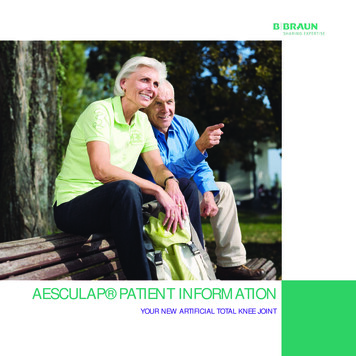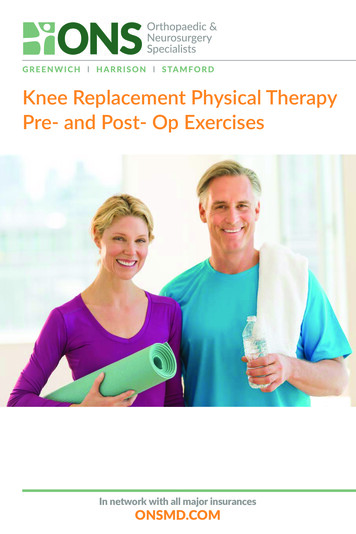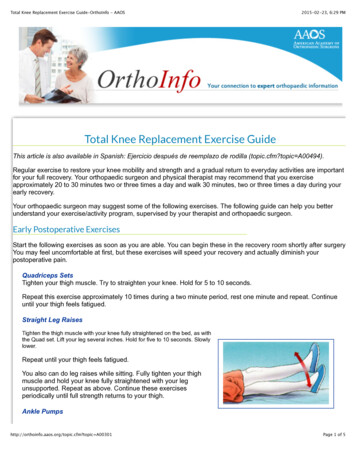
Transcription
Total Knee Replacement Exercise Guide-OrthoInfo - AAOS2015-02-23, 6:29 PMTotal Knee Replacement Exercise GuideThis article is also available in Spanish: Ejercicio después de reemplazo de rodilla (topic.cfm?topic A00494).Regular exercise to restore your knee mobility and strength and a gradual return to everyday activities are importantfor your full recovery. Your orthopaedic surgeon and physical therapist may recommend that you exerciseapproximately 20 to 30 minutes two or three times a day and walk 30 minutes, two or three times a day during yourearly recovery.Your orthopaedic surgeon may suggest some of the following exercises. The following guide can help you betterunderstand your exercise/activity program, supervised by your therapist and orthopaedic surgeon.Early Postoperative ExercisesStart the following exercises as soon as you are able. You can begin these in the recovery room shortly after surgery.You may feel uncomfortable at first, but these exercises will speed your recovery and actually diminish yourpostoperative pain.Quadriceps SetsTighten your thigh muscle. Try to straighten your knee. Hold for 5 to 10 seconds.Repeat this exercise approximately 10 times during a two minute period, rest one minute and repeat. Continueuntil your thigh feels fatigued.Straight Leg RaisesTighten the thigh muscle with your knee fully straightened on the bed, as withthe Quad set. Lift your leg several inches. Hold for five to 10 seconds. Slowlylower.Repeat until your thigh feels fatigued.You also can do leg raises while sitting. Fully tighten your thighmuscle and hold your knee fully straightened with your legunsupported. Repeat as above. Continue these exercisesperiodically until full strength returns to your thigh.Ankle Pumpshttp://orthoinfo.aaos.org/topic.cfm?topic A00301Page 1 of 5
Total Knee Replacement Exercise Guide-OrthoInfo - AAOS2015-02-23, 6:29 PMMove your foot up and down rhythmically by contracting the calf and shin muscles. Performthis exercise periodically for two to three minutes, two or three times an hour in the recoveryroom.Continue this exercise until you are fully recovered and all ankle and lower-legswelling has subsided.Knee Straightening ExercisesPlace a small rolled towel just above your heel so that it is not touching the bed. Tightenyour thigh. Try to fully straighten your knee and to touch the back of your knee to thebed. Hold fully straightened for five to 10 seconds.Repeat until your thigh feels fatigued.Bed-Supported Knee BendsBend your knee as much as possible whilesliding your foot on the bed. Hold your knee in amaximally bent position for 5 to 10 seconds andthen straighten.Repeat several times until your leg feelsfatigued or until you can completely bendyour knee.Sitting Supported Knee BendsWhile sitting at bedside or in a chair with your thigh supported, place your foot behind the heel of youroperated knee for support. Slowly bend your knee as far as you can. Hold your knee in this position for5 to 10 seconds.Repeat several times until your leg feels fatigued or until you can completely bend yourknee.Sitting Unsupported Knee BendsWhile sitting at bedside or in a chair with your thigh supported, bend yourknee as far as you can until your foot rests on the floor. With your foot lightlyresting on the floor, slide your upper body forward in the chair to increaseyour knee bend. Hold for 5 to 10 seconds. Straighten your knee fully.Repeat several times until your leg feels fatigued or until you cancompletely bend your knee.Early ActivitySoon after your surgery, you will begin to walk short distances in your hospital room and perform everyday activities.This early activity aids your recovery and helps your knee regain its strength and movement.WalkingProper walking is the best way to help your knee recover. At first, you will walk with a walker or crutches. Your surgeon ortherapist will tell you how much weight to put on your leg.http://orthoinfo.aaos.org/topic.cfm?topic A00301Page 2 of 5
Total Knee Replacement Exercise Guide-OrthoInfo - AAOS2015-02-23, 6:29 PMStand comfortably and erect with your weight evenly balanced on your walker orcrutches. Advance your walker or crutches a short distance; then reach forward with youroperated leg with your knee straightened so the heel of your foot touches the floor first.As you move forward, your knee and ankle will bend and your entire foot will rest evenlyon the floor. As you complete the step, your toe will lift off the floor and your knee and hipwill bend so that you can reach forward for your next step. Remember, touch your heelfirst, then flatten your foot, then lift your toes off the floor.Walk as rhythmically and smooth as you can. Don't hurry. Adjust the length of your step and speed asnecessary to walk with an even pattern. As your muscle strength and endurance improve, you mayspend more time walking. You will gradually put more weight on your leg. You may use a cane in thehand opposite your surgery and eventually walk without an aid.When you can walk and stand for more than 10 minutes and your knee is strong enoughso that you are not carrying any weight on your walker or crutches (often about two tothree weeks after your surgery), you can begin using a single crutch or cane. Hold the aidin the hand opposite the side of your surgery. You should not limp or lean away from youroperated knee.Stair Climbing and DescendingThe ability to go up and down stairs requires strength and flexibility. At first, you will need a handrail forsupport and will be able to go only one step at a time. Always lead up the stairs with your good knee anddown the stairs with your operated knee. Remember, "up with the good" and "down with the bad." Youmay want to have someone help you until you have regained most of your strength and mobility.Stair climbing is an excellent strengthening and endurance activity. Do not try to climbsteps higher than the standard height (7 inches) and always use a handrail for balance. Asyou become stronger and more mobile, you can begin to climb stairs foot over foot.Advanced Exercises and ActivitiesOnce you have regained independence for short distances and a few steps, you may increase your activity. The painof your knee problems before surgery and the pain and swelling after surgery have weakened your knee. A fullrecovery will take many months. The following exercises and activities will help you recover fully.http://orthoinfo.aaos.org/topic.cfm?topic A00301Page 3 of 5
Total Knee Replacement Exercise Guide-OrthoInfo - AAOS2015-02-23, 6:29 PMStanding Knee BendsStanding erect with the aid of a walker or crutches, lift your thigh and bend your knee as much asyou can. Hold for 5 to 10 seconds. Then straighten your knee, touching the floor with your heelfirst. Repeat several times until fatigued.Assisted Knee BendsLying on your back, place a folded towel over your operated knee and drop thetowel to your foot. Bend your knee and apply gentle pressure through the towel toincrease the bend.Hold for 5 to 10 seconds; repeat several times until fatigued.Knee Exercises with ResistanceYou can place light weights around your ankle and repeat any of the above exercises. These resistanceexercises usually can begin four to six weeks after your surgery. Use one- to two-pound weights at first;gradually increase the weight as your strength returns. (Inexpensive wrap-around ankle weights with Velcrostraps can be purchased at most sporting goods stores.)ExercyclingExercycling is an excellent activity to help you regain muscle strength and knee mobility. At first, adjustthe seat height so that the bottom of your foot just touches the pedal with your knee almost straight.Peddle backward at first. Ride forward only after a comfortable cycling motion is possible backwards.As you become stronger (at about four to six weeks) slowly increase the tension on theexercycle. Exercycle for 10 to 15 minutes twice a day, gradually build up to 20 to 30minutes, three or four times a week.Pain or Swelling after Exercise You may experience knee pain or swelling after exercise or activity.You can relieve this by elevating your leg and applying ice wrapped in a towel. Exercise and activityshould consistently improve your strength and mobility. If you have any questions or problems, contactyour orthopaedic surgeon or physical therapist.Last reviewed: March 2011AAOS does not endorse any treatments, procedures, products, or physicians referenced herein. This information is provided as aneducational service and is not intended to serve as medical advice. Anyone seeking specific orthopaedic advice or assistance shouldconsult his or her orthopaedic surgeon, or locate one in your area through the AAOS "Find an Orthopaedist" program on this website.Copyright 2011 American Academy of Orthopaedic Surgeonshttp://orthoinfo.aaos.org/topic.cfm?topic A00301Page 4 of 5
Total Knee Replacement Exercise Guide-OrthoInfo - AAOS2015-02-23, 6:29 PMRelated ArticlesActivities After Knee Replacement (http://orthoinfo.aaos.org/topic.cfm?topic A00357)Ejercicio después de reemplazo de rodilla (http://orthoinfo.aaos.org/topic.cfm?topic A00494)Total Knee Replacement (http://orthoinfo.aaos.org/topic.cfm?topic A00389)OrthoInfoThe American Academy of Orthopaedic Surgeons9400 West Higgins RoadRosemont, IL 60018Phone: 847.823.7186Email: cfm?topic A00301Page 5 of 5
knee. Sitting Unsupported Knee Bends While sitting at bedside or in a chair with your thigh supported, bend your knee as far as you can until your foot rests on the floor. With your foot lightly resting on the floor, slide your upper body forward in the chair to increase your knee bend. Hold for 5 to 10 seconds. Straighten your knee fully.
